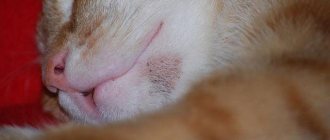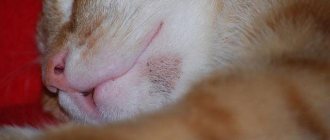The Murkoshi team has long been asking questions: “Why can kittens develop acne on their bodies?”, “How serious is this for health?”, “How does this manifest itself in everyday life?” and, of course, “How is the disease treated?” Let's try to delve into this topic and figure it out together.
1) What is acne in cats 2) Why does acne appear in cats 3) How to determine that a cat has acne 4) Treatment of acne in cats 5) How to protect a cat from acne 6) Does acne occur in small kittens and how to treat it
What is acne in cats
Acne in cats is a fairly common skin disease accompanied by inflammation of the sebaceous glands. It looks like human acne - in the form of small black dots. Most often, the pathology appears on the chin or near the lip. In addition, the disease can form at the root of the tail.
Cats of any breed and any age can get acne. This is a serious disease that can lead to other pathologies. Therefore, it is very important to notice a cat’s illness in a timely manner and take all necessary measures to eliminate it.
Illustrations
Acne on the Neck
Atopic miliary dermatitis
Demodectic mange in cats
Malassezia Dermatitis
Pemphigus
Why does acne appear in cats?
Black pimples appear in cats due to the fact that the sebaceous glands become inflamed. And they become inflamed due to the accumulation of bacteria, dust and other microparticles and microorganisms. The causes of acne are different:
— Severe stress can cause problems with the secretion of the sebaceous glands. Negative emotions provoke abundant production of sebaceous secretions. The glands cannot cope with their work and become clogged. — The most common reason for the appearance of black spots in cats is a lack of necessary hygiene in those places where the animal cannot clean the skin on its own. These are the chin, the bottom of the lip and the root of the tail. - Activity of the sebaceous glands. And, as a result, various skin diseases that provoke the appearance of acne. — Incorrect structure of the cat’s body, in particular the structure of the sebaceous glands or hair follicles. - Reduced immunity. - Cat food bowls can cause inflammation in the lip area if they are made of plastic.
Fun fact: Dogs are less prone to acne than cats.
Tips for cleaning your cat's face if she has acne
For most patients, improving hygiene is a key part of the treatment plan; In other words, you will need to start washing your cat's face.
Your veterinarian may recommend cleansing the face with benzoyl peroxide facial wipes, but you'll need to purchase wipes specifically made for cats as wipes for humans are too strong.
Trimming nearby fur can also reduce bacteria counts.
Some cats may also benefit from cleaning their water and food utensils more frequently and switching to stainless steel, glass or ceramic utensils.
How to tell if a cat has acne
If the disease has not become severe, the symptoms are almost impossible to notice. If the pathology has reached a moderate or severe stage, then the symptoms will certainly manifest themselves. Main symptoms:
- the main symptom is a white pimple, which later turns black; - redness of the skin at the site of inflammation; - swelling of the skin in the area of the rash; - the appearance of pustules of both small and large sizes; - baldness of the disease area; - severe itching, causing the cat to scratch the skin vigorously; - formation of wounds due to the pet scratching the skin.
By the way, there are many diseases that are similar to acne. It is very important to take your cat to the vet in a timely manner and rule out the presence of severe pathologies. In addition, the doctor will not only be able to provide qualified assistance, but also give some valuable advice on caring for your pet.
Treatment for cat acne
NEVER pick your cat's pimples. Squeezing will only make the condition worse and potentially cause more pain and even infection.
Initial treatment may include the use of oral or injected antibiotics and topical shampoo or wipes.
If your cat's skin begins to clear up, shampoos and topical treatments can be gradually discontinued, but if outbreaks recur, your veterinarian will help develop an appropriate care regimen to keep your cat's chin as clear as possible.
Maintenance brushing with a gentle scrub has proven successful for many cats because it increases the time between attacks and treatment.
Treatment of acne in cats
Murkoshi veterinarians advise treating cats immediately after the disease is detected. This is a serious pathology that can lead to irreparable consequences if treatment is avoided. If you do not provide timely assistance to your cat, there is a risk of greater inflammation and severe suppuration. The pet is suffering and experiencing severe discomfort. Therefore, it is very important to properly and timely treat your beloved cat and save it from suffering.
1. It is better to shave the hair on the affected area to minimize the accumulation of sweat and speed up the healing process. 2. You need to regularly wash the affected areas of the skin with a special medicated shampoo. 3. Before applying the medicinal ointment, be sure to wipe the area with 3% hydrogen peroxide.
A mild form of the disease goes away on its own – you just need to eliminate the cause of the disease, normalize the normal emotional state, and restore the pet’s immunity. If the situation is serious, a secondary infection may occur, and then the doctor will prescribe the cat a topical antibiotic and a loading dose of vitamin A.
Feline miliary dermatitis
Miliary dermatitis is called eczema and even cat mangy. This is a common cat disease. Veterinary dermatologists prefer to call this condition a special skin reaction. Indeed, these are symptoms of many diseases. Cat skin has a limited number of options for responding to different disease conditions. A small rash that feels like sandpaper and is accompanied by itching is not a disease, but a symptom of a disease.
Miliary dermatitis is a scattering of small pimples, or nodules, on the skin, localized or covering the entire body. Typically, these pimples crust over and turn into scabs that can be easily felt through the cat's fur when you pet your cat. The term “miliary” means “millet-like” - the nodules feel like grains of millet to the touch.
Countless reasons. Typically, this skin condition is a sign of hypersensitivity, an allergic reaction of the animal to a variety of things. The most common causes are flea allergies, respiratory allergies, or food allergies. Increased sensitivity to skin parasites can cause the same symptoms.
Infectious diseases such as ringworm can also cause miliary dermatitis. Even bacteria, immune disorders, reactions to medications and digestive problems can manifest as crusts on the skin. One in six cases of miliary dermatitis is idiopathic , meaning that the cause cannot be determined. To cure this skin condition, you need to identify its cause and eliminate it.
Establishing diagnosis. The location of the rash on the body can often provide an indication of its cause. If the rash is on the head and neck, then most likely it is a food allergy. If the base of the tail is affected, it is most often a reaction to fleas. If a rash is noted throughout the body, doctors suspect respiratory allergies or atopy. Flea allergies and atopy are seasonal phenomena, while cats suffer from food allergies all year round.
Treatment for miliary dermatitis begins with a series of tests aimed at identifying the cause of the condition. Fleas are probably the most common culprit. Since even one flea bite causes an allergic reaction, and cats themselves lick themselves zealously, it can be difficult to detect traces of fleas in a cat’s fur coat. You can suggest this way of checking for fleas: you scratch-scratch-scratch the cat's coat and put all the combed dirt on a wet white cloth. If it is flea excrement, then the black specks turn red.
Respiratory allergies are often caused by pollen, mold and indoor dust , and diagnosis requires intradermal testing. Suspected allergens are placed inside the skin (not under the skin) by scratching a shaved area of the cat's skin, which has previously been given a sedative. In the case of a positive reaction, the scratch swells and becomes redder after 5-15 minutes; in a negative reaction, there is no inflammation.
If miliary dermatitis is a food allergy, the rash will persist as long as the cat is exposed to that type of food. To diagnose a food allergy, a cat is put on a diet that includes ingredients it has never eaten before. If symptoms disappear, then some component of the old diet is to blame for the disease. These old components are added one by one to the new diet and monitored which one will cause an allergic reaction. This diagnostic feeding can last up to 12 weeks and should be done under medical supervision.
Miliary dermatitis in the armpit
Almost every cat with miliary dermatitis has several different skin scrapings taken to determine whether there are skin parasites. Three species of Cheyletiella mites cause skin lesions, also called dandruff, because the white, moving parasites are often mistaken for skin flakes. These mites live in the horny substance (keratin) of the outer layer of skin. Cats become infected with them either through direct contact with infected cats, or through indirect contact with other parasites that carry this mite, such as fleas, lice and flies.
Otodectes cynotis, also known as the ear mite, can also cause miliary dermatitis on the head and neck. About three percent of cases of miliary dermatitis are caused by ear scabies.
Rarely found in cats, demodicosis is known as glandular mange and is caused by the mite Demodex cati, which lives in the hair follicle (hair follicle). It can also cause miliary dermatitis.
Cats suffering from pediculosis , that is, infected with the lice-eater Felicola subrostratus, or chewing louse, may also show signs of miliary dermatitis .
Ringworm in cats can be caused by Microsporum gypseum, Trichophyton mentagrophytes or Microsporum canis, with the latter being the causative agent in most cases. But any of the above parasites can cause signs of miliary dermatitis along with ringworm symptoms such as bald spots and redness of the skin. Therefore, when diagnosing stubborn miliary dermatitis, it is recommended to do a ringworm test. The wool from the affected area is placed in a special nutrient medium (Sabouraud, Chapek agars) and incubated for at least 15 days.
Treating itching is not treating the disease. If you use standard allergy treatment, the symptoms of miliary dermatitis may be relieved, but they will return if this treatment is stopped. It is necessary to constantly monitor the presence of fleas in a cat if she is allergic to fleas. There are a huge number of products available on the market for the safe removal of fleas both from a cat and from its surrounding home environment.
The best therapy for respiratory allergies, according to experts, is frequent bathing of the cat: in this case, you wash off the allergen from its fur. A mild shampoo that does not dry out the skin or simply rinsing the cat with clean water is suitable for this. Some cats susceptible to atopy benefit from immunotherapy. Once the causative agent of the allergy is identified, the cat is given a series of injections of a drug based on this allergen in order to increase the resistance of the animal’s own immune system. Results appear slowly, and treatment usually lasts a year or more. Maintenance, preventive injections can be repeated periodically to make the cat feel more comfortable.
Miliary dermatitis caused by food allergies goes away as soon as you can find a suitable diet.
With the exception of the Demodex mite, the skin parasites that cause miliary dermatitis are highly contagious, and if such an infection is detected, all animals in the household should be treated. Treatment consists of weekly treatment of animals with appropriate drugs for three to four weeks. After this first period of treatment, tests are done to check for parasites. If the test results are positive (that is, confirming the presence of the parasite), treatment continues with weekly screening tests until a negative result is obtained. After this, treatment continues for another week to consolidate the effect.
Many hidden causes of dermatitis can be treated well with cortisone. Steroids and antibiotics are prescribed to relieve severe itching or kill infection.
But the diagnosis of the root cause of dermatitis is very important; there is no point in treating itching by itself. The painful condition may worsen if ringworm is treated with cortisone. Modern therapy for ringworm should include the use of a new vaccine against Microsporum canis in combination with medical baths, local ointments and environmental disinfection.
Source: Galina Starostina
How to protect your cat from acne
1. Specialists at the Murkosha shelter recommend monitoring your cat’s hygiene. We all know that cats are clean animals that lick themselves. But there are places where a cat's tongue cannot reach - these are the chin, lower lip and the root of the tail. It is necessary to periodically wipe these areas with a cotton pad soaked in warm water or a damp antibacterial wipe.
2. Avoid using plastic bowls to feed your pets. They have tiny pores that tend to absorb bacteria from the environment. And, as a result, it spreads to the delicate skin around the lips of your beloved cat, gradually contaminating the sebaceous glands and forming inflammation. It is better to use metal bowls to feed your cat. In addition, it is important to ensure that drinking water is updated daily.
3. You should exclude fatty foods from your cat's diet if you notice a tendency toward acne. This way, the sebaceous glands will not become clogged with excess fat in the body and your pet will be healthy.
Read more about how to feed cats: Proper nutrition for cats
4. It is important to strengthen your cat’s immunity. Provide her with a daily nutritious diet that contains vitamins, minerals, omega 3 and other beneficial substances. "Murkosha" recommends super premium and holistic food - they have everything you need.
“A house with a cat needs no other decorations.” Wesley Bates
Does acne occur in small kittens and how to treat it?
Unfortunately, young kittens also get acne. But prevention, treatment and symptoms are identical to those of an adult cat. The main thing is to always monitor the kitten’s appearance and promptly identify the signals it gives you. And wipe your pet’s chin after each meal with a disinfectant wipe or cotton pad with chlorhexedine.
Read more about how to care for a small kitten: How to feed a kitten with a syringe: methods, portions, food, regimen
Thus, acne can appear in a cat at any age. To prevent this from happening, you need to monitor your pet’s hygiene and provide him with a balanced diet. If you still notice black spots on your cat, be sure to show him to the veterinarian, and then strictly follow all the specialist’s instructions.
What can be done
You may genuinely not understand why your cat is constantly licking and scratching. Visit a veterinarian and he will recommend a drug that alleviates the animal’s condition or select a suitable dietary food. You may even need to use certain medications to treat skin reactions. It is important to monitor your cat during treatment to ensure that its condition improves and not the other way around. If the problem is not resolved, you may be dealing with another skin condition. During the examination, the veterinarian will provide the pet with the necessary assistance. Make a list of all the symptoms you notice in your cat to make it easier for your doctor to diagnose the disease.
You love your cat and will not watch her suffer. Although your pet takes great care of her appearance, check her skin and coat regularly to detect any problems. Pay attention to changes in skin odor, itching, and changes in your washing routine. The sooner you notice the problem, the better for your cat.
Contributor Bio
Erin Ollila
Erin Ollila believes in the power of words, that her message can bring a lot to people and even change them. Her writing can be found all over the internet and in print, and includes interviews, articles, blog posts and creative non-fiction. Erin is a fan of SEO and all things social media. She graduated from Fairfield University with a Master of Arts in Creative Writing. You can find her on Twitter @ReinventingErin or learn more about her at https://erinollila.com.











